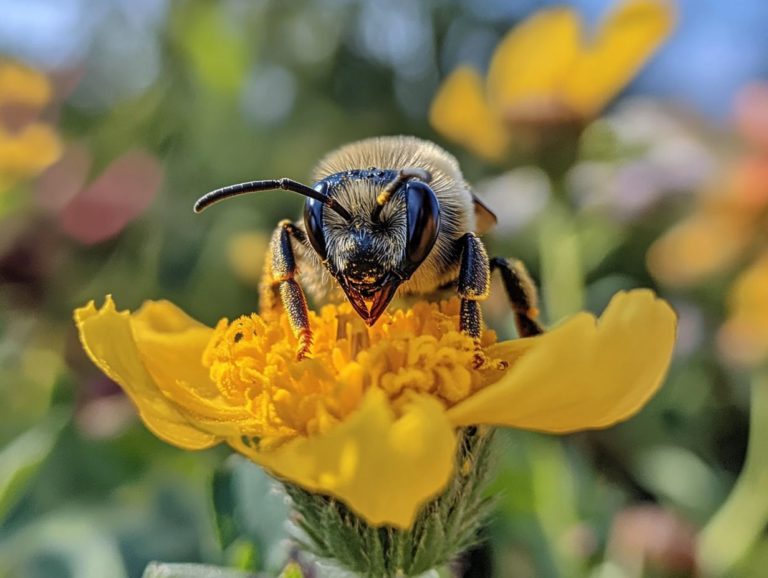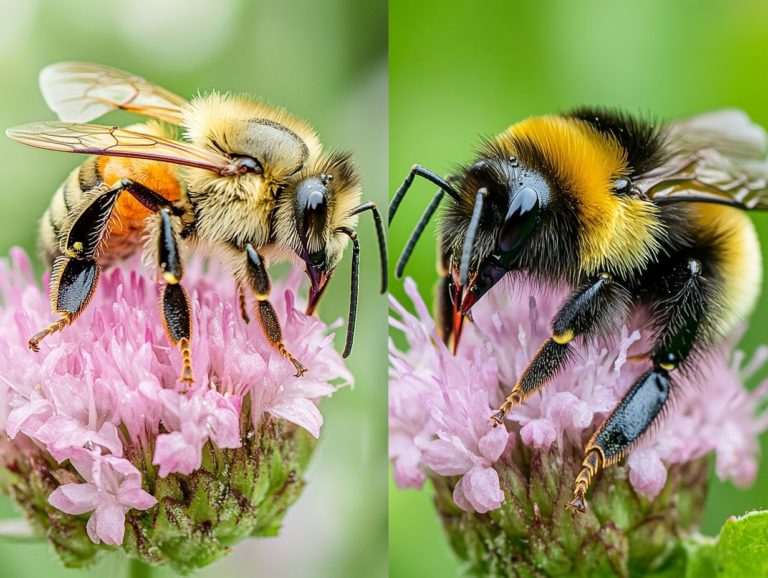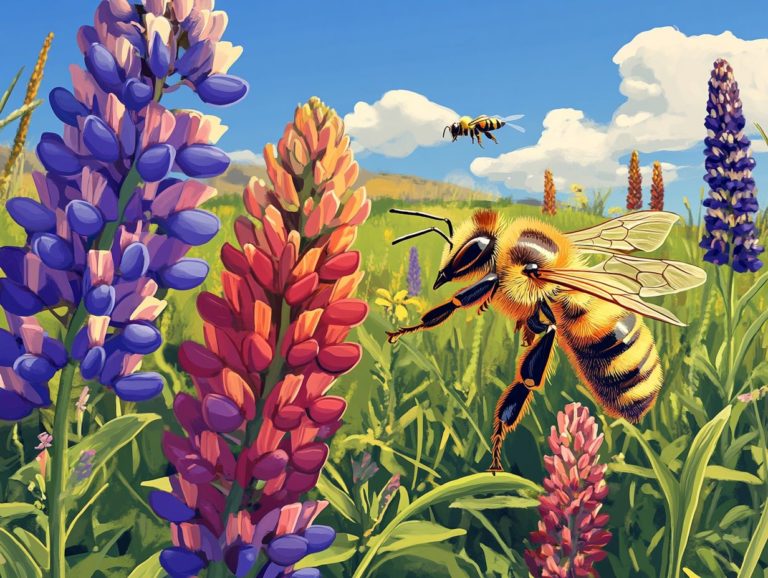5 Most Interesting Bee Species Worldwide
Bees play a vital role in our ecosystem, yet many individuals remain unaware of the incredible diversity among bee species, especially native bees.
From the industrious Western Honey Bee to the striking Blue-Banded Bee, each species possesses unique characteristics and contributes in its own way to the environment. You ll discover five fascinating bee species, including both small bee species and large bee species, each highlighting its distinct traits, the challenges it encounters, and its significance in pollination and biodiversity.
Dive into this exploration as you uncover what makes these remarkable insects essential. Learn how you can help protect their future through bee conservation initiatives and understanding the environmental impact of their decline.
Contents
- Key Takeaways:
- 1. The Western Honey Bee (Apis mellifera)
- 2. The Bumblebee (Bombus spp.)
- 3. The Carpenter Bee (Xylocopa spp.)
- 4. The Orchid Bee (Euglossini)
- 5. The Blue-Banded Bee (Amegilla bombiformis)
- Why Are Bees Important for the Environment?
- Frequently Asked Questions
- Have you ever wondered about the most fascinating bee species around the world?
- What makes orchid bees unique among other bee species?
- How do carpenter bees differ from other bee species?
- Why are honey bees considered one of the most interesting bee species worldwide?
- What sets bumblebees apart from other bee species?
- How do stingless bees contribute to the ecosystem?
Key Takeaways:

- Did you know that the Western Honey Bee is the most well-known and important bee species, responsible for pollinating one-third of the world’s food supply?
- Did you know that bumblebees, with their fuzzy bodies and unique buzzing sounds, play a crucial role in pollination and can fly in cool and cloudy weather?
- Did you know that carpenter bees are skilled at creating nests but can also damage wooden structures?
- Did you know that understanding bee diversity, including solitary bees and their unique nests, is crucial for effective conservation efforts?
1. The Western Honey Bee (Apis mellifera)
The Western Honey Bee, a crucial member of the Apidae family, plays an essential role in honey production and agricultural pollination. This remarkable bee showcases unique behaviors and adaptations that enhance its efficiency across diverse ecosystems, highlighting its significance in the pollination process and the relationships it nurtures with flowers, other bees, and its habitats. Bee research studies continually uncover new aspects of their behavior and ecology, making them a focal point for entomologists.
With well-organized colonies composed of a queen, workers, and drones, the Western Honey Bee presents a captivating social structure fundamental to its productivity. Its foraging behavior how bees search for food is essential for gathering nectar and pollen from a broad spectrum of plants. This supports honey production, a natural sweetener cherished by many cultures, and ensures the fertility of countless flowering plants that rely on these bees for successful reproduction.
Bee monitoring programs, such as those conducted by the USGS Bee Inventory and Monitoring Program, are essential for tracking the health and population trends of these vital pollinators.
The Western Honey Bee employs intricate dances and pheromones, which are chemical signals that bees use to communicate, fostering teamwork within the hive and enhancing its foraging strategies. However, recent studies underscore the threats posed by habitat loss and pesticide exposure. It s crucial that we act now to conserve these amazing creatures and the vital services they provide!
2. The Bumblebee (Bombus spp.)
The Bumblebee, which includes remarkable species like Bombus hortorum and Bombus impatiens, holds a vital position in the pollination process, especially in cooler climates where other bee species might find it challenging to thrive. Bumblebees are often studied in bee research for their unique pollination techniques and resilience in adverse weather conditions.
These intriguing insects are easily recognized by their robust bodies and distinctive fuzzy appearance, traits that facilitate their pollen collection. Unlike honeybees, bumblebees have unique nesting habits, often opting for small colonies in abandoned rodent burrows or nestled on the ground, making them less conspicuous in their habitats.
Regarding foraging, bumblebees are uniquely equipped, boasting strong wings that enable them to fly even in cooler temperatures. This remarkable resilience is crucial for the ecosystem, as they play a significant role in pollinating a variety of plants, thereby fostering biodiversity and enhancing food production.
Their diligent work in pollinating crops further highlights their importance in supporting the health of global bee populations, creating a mutual relationship that benefits both plants and animals alike.
Join us in protecting bees by supporting local conservation initiatives!
3. The Carpenter Bee (Xylocopa spp.)
The Carpenter Bee, especially the species Xylocopa violacea, stands out for its nests built alone. It artfully crafts unique nests by boring into wood a remarkable adaptation to its environment. These bees are often found in bee identification guides due to their distinctive nesting behavior and impact on wooden structures.
These nests are complex networks of interconnected tunnels. They provide a safe haven for their larvae and showcase the bee’s impressive ability to make the most of available resources. As essential pollinators, Carpenter Bees interact with a variety of flowering plants, facilitating the transfer of pollen as they diligently forage for nectar. This relationship is vital for plant reproduction and boosts biodiversity in ecosystems.
Despite their crucial role in nature, these bees face many threats such as habitat loss, pesticide exposure, and competition from other species. The urgent need for conservation efforts is clear; we must act now to protect their homes and food sources.
4. The Orchid Bee (Euglossini)

The Orchid Bee, a captivating member of the Megachilidae family, serves as a prime example of flower-loving bees. With their vibrant colors and behaviors resembling those of butterflies, these bees hold a unique place in the diverse world of pollinators. Their butterfly mimicry is a fascinating subject in bee ecology studies.
These bees are instrumental in pollinating not just orchids but also many flowering plants, making them vital to the health of various ecosystems. Their intricate behaviors are truly fascinating. For instance, Orchid Bees have adapted to collect and store fragrances to attract mates and establish their territory.
Research reveals that their interactions with plants play a critical role in promoting genetic diversity and enhancing the reproductive success of many species. This mutualistic relationship beautifully illustrates the delicate balance within ecosystems, where the well-being of Orchid Bees is directly linked to the abundance and variety of flora.
5. The Blue-Banded Bee (Amegilla bombiformis)
The Blue-Banded Bee, specifically Amegilla bombiformis, captivates with its striking appearance and unique foraging patterns. It establishes itself as a crucial pollinator in various ecosystems that play a significant role in environmental health. These bees are often studied in Australia for their unique adaptations to the local environment.
This remarkable bee showcases distinctive behaviors, including a fascinating way of using sound to shake pollen from flowers. They buzz at specific frequencies to dislodge pollen from particular flowers, demonstrating impressive adaptations. When visiting tubular-shaped blossoms, their body structure allows them to navigate these intricate designs with ease, ensuring highly effective pollination.
As they move from flower to flower, they not only transfer pollen but also facilitate the reproductive processes of numerous plants. This provides essential support to biodiversity. However, their habitats are increasingly threatened by urbanization and agricultural practices, highlighting the urgent need for conservation efforts to maintain healthy ecosystems.
Why Are Bees Important for the Environment?
Bees, belonging to diverse bee families such as Apidae and Megachilidae, are absolutely essential to our environment, playing a pivotal role in the pollination process that sustains both wild and cultivated plants. This, in turn, supports global biodiversity and food production. The importance of their role in maintaining healthy ecosystems becomes even more apparent when considering the alarming decline in bee populations, making urgent conservation efforts essential to protect these vital insects and their habitats.
Bees are absolutely essential to our environment, playing a pivotal role in the pollination process that sustains both wild and cultivated plants. This, in turn, supports global biodiversity and food production. The importance of their role in maintaining healthy ecosystems becomes even more apparent when considering the alarming decline in bee populations, making urgent conservation efforts essential to protect these vital insects and their habitats.
It s estimated that around 75% of the world s flowering plants rely on animal pollinators, with bees as the standout stars. This not only enhances the vibrancy of ecosystems but also has significant economic implications; honey production alone brings in billions of dollars each year. The honey production process is a subject of extensive study due to its economic and ecological significance.
Regrettably, these crucial pollinators are facing a myriad of threats, such as habitat loss, pesticide exposure, and invasive species that disrupt their natural environments. In response, organizations like Global Wildlife Conservation and institutions like Princeton University and University of Sydney are stepping up their efforts to safeguard these remarkable creatures through habitat restoration and awareness campaigns. They emphasize the vital link between biodiversity and agricultural productivity, reminding us all of the interconnectedness of our ecosystem.
How Do These Bee Species Contribute to the Ecosystem?
Different bee species, including both solitary bees and social bees, play unique and vital roles in ecosystems, particularly through their essential contributions to the pollination process, which is crucial for the reproduction of many plants and the production of fruits and seeds.
Different bee species play unique and vital roles in ecosystems, particularly through their essential contributions to the pollination process, which is crucial for the reproduction of many plants and the production of fruits and seeds.
Take honey bees, for example. Their remarkable efficiency in pollinating a wide range of agricultural crops has been extensively documented, leading to impressive yields of fruits and vegetables. Then there are bumblebees, which possess the unique ability to vibrate flowers and effectively release pollen, making them essential for crops like tomatoes and blueberries. And let’s not overlook solitary bees, comprising nearly 70% of the world’s bee species; they are equally important pollinators for wild plants and diverse ecosystems. For more information, you can explore the top 5 most common bee species. The State of the Honey Bee Report highlights the contributions of different types of bees in maintaining ecological balance.
The decline of these critical pollinators poses a serious threat to biodiversity, with repercussions for food systems and natural habitats. When these pollinators diminish, the variety of flourishing plants decreases, disrupting the intricate balance within ecosystems and ultimately impacting wildlife that depends on those plants for shelter and sustenance.
What Are the Unique Characteristics of Each Bee Species?

Each species, from the energetic honey bee to the elusive nocturnal bee, showcases unique characteristics that make them fascinating subjects for bee expert insights and natural history studies.
Each bee species exhibits distinct characteristics that enable it to thrive in its particular environment. This includes the intricate social structures of honey bees and the solitary nesting habits of bee families known for their unique behaviors, such as the Andrenidae and Halictidae.
This remarkable adaptability enables bees to fulfill specific roles within their ecosystems as they interact with a diverse array of flowering plants. For example, bumblebees excel at foraging in cooler temperatures, making them vital pollinators for early spring blooms.
The specialized mouthparts of long-tongued bees, such as the Megachile from the Megachilidae family, allow them to access nectar from deep flowers. This showcases how these unique biological traits enhance their interactions with various plant species.
The ecological niches occupied by these bees highlight the critical importance of maintaining biodiversity. The loss of even a single bee family could disrupt the delicate balance of our ecosystems, emphasizing the need for their preservation and conservation efforts.
What Are the Threats to These Bee Species?
Bee species encounter many threats, including habitat loss, climate change, and the encroachment of invasive species. These factors collectively jeopardize bee populations and their crucial roles within ecosystems.
Among the notable invasive species impacting bees are non-native bees and pests. These threats endanger many bee species and impede their essential contributions, such as pollination, which is critical for producing fruits, vegetables, and nuts.
Invasive species, including certain non-native bees and pests, can easily outcompete local bees for resources and potentially introduce diseases. This further destabilizes local ecosystems and highlights why we must invest in bee research.
The decline in bee populations has serious implications for biodiversity and food security, igniting initiatives worldwide aimed at monitoring these crucial insects. These efforts often involve citizen science projects, bee monitoring, and collaborative research, all designed to track population changes and assess the health of diverse species.
By collecting data on bee performance across various habitats, you and the scientific community can work together to develop targeted conservation strategies that ensure the survival of these vital pollinators. This data is often collected through bee monitoring programs, such as those led by the USGS Bee Inventory and Monitoring Program.
It’s vital that we act now to protect these essential pollinators!
How Can We Help Protect and Preserve These Bee Species?
Protecting bee species requires a multifaceted approach. This includes engaging the community, restoring habitats, and raising awareness about the environmental impact of declining bee populations. Efforts from institutions like the Global Wildlife Conservation and universities such as Princeton University and the University of Sydney play a significant role in these initiatives.
To embark on this journey, you can begin by planting bee-friendly gardens with native flowers that provide nectar and pollen. By doing so, you contribute to a supportive ecosystem for these vital pollinators. Bee-friendly gardens replicate the natural habitats of bees, thus supporting both small bee species and large bee species.
You can rally your community to participate in local conservation efforts. Organizing clean-up days in parks or planting wildflowers in neglected areas can make a significant difference. Local guides and bee experts can provide valuable insights on the best practices to enhance these efforts.
Educational programs in schools or public workshops can serve as powerful tools to raise awareness about the critical role bees play in our ecosystem and food production. You ll find that successful initiatives, such as urban beekeeping projects that engage local residents, demonstrate the impact of collective action in enhancing bee habitats and supporting their populations. These initiatives often highlight the honey production process and the unique characteristics of different bee species.
These efforts not only help the bees but also create a healthier environment for all of us! Let’s make a difference together. They also emphasize the global abundance of bees and the importance of maintaining the diversity of bee habitats.
What Can We Learn from These Fascinating Bee Species?
Studying the diverse species of bees offers you invaluable insights into their complex behaviors, adaptations, and the critical roles they play in our ecosystems. It’s a journey that not only enlightens you about ecology but also deepens your understanding of biodiversity and conservation. Bee research studies, led by experts like Noah Wilson-Rich, provide deeper insights into bee behavior and conservation strategies.
Ongoing research into bee populations is crucial for you, as it reveals the intricate relationships these pollinators maintain within various habitats. Experts emphasize that by understanding how environmental changes impact bee behavior and reproduction, you can inform conservation strategies and enhance efforts to improve living spaces for bees. The State of the Honey Bee Report provides critical data on these aspects.
By looking into the genetic diversity among bee species, you can help researchers develop more effective approaches to protect these vital insects. The implications of such studies reach far beyond biodiversity; they underpin the sustainability of agricultural practices and ensure food security. Understanding genetic diversity also aids in the classification of bee species and informs bee species classification efforts.
Therefore, the urgency of bee research cannot be overstated for you. It plays a fundamental role in safeguarding ecological health and maintaining the delicate balance of nature. This research not only benefits honey bees but also native bees and other diverse species.
Frequently Asked Questions

Have you ever wondered about the most fascinating bee species around the world?
The 5 most interesting bee species worldwide are the orchid bees, carpenter bees, honey bees, bumblebees, and stingless bees.
What makes orchid bees unique among other bee species?
Orchid bees are known for their vibrant metallic colors and their ability to collect and store floral fragrances, making them important pollinators for orchids.
How do carpenter bees differ from other bee species?
Carpenter bees are known for their ability to drill holes into wood to create their nests, making them important for the pollination of plants that other bees cannot reach.
Why are honey bees considered one of the most interesting bee species worldwide?
Honey bees have evolved advanced communication and navigation systems, work in highly organized colonies, and play a vital role in pollination and honey production.
What sets bumblebees apart from other bee species?
Bumblebees have a remarkable knack for regulating their body temperature. This ability allows them to fly in cooler weather and become active earlier in the spring than other bees.
How do stingless bees contribute to the ecosystem?
Stingless bees, also called meliponines, are vital pollinators in tropical regions. Indigenous communities rely on them for honey production and medicinal purposes.






